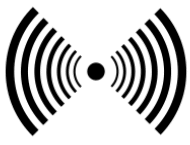


|
200 Hz |
210 Hz |
|
300 Hz |
220 Hz |
|
400 Hz |
230 Hz |
|
500 Hz |
240 Hz |
|
600 Hz |
290 Hz |
The 300 Hz and 290 Hz sounds create the strongest dissonance because they are the closest to each other, but not close enough to be interpreted as the same sound. You can hear the "beats" in this combination, which are occuring 10 times per second, which is the difference between the two frequencies.
Each instrument has frequencies in addition to the fundamental frequency that combine to create the instrument's distinctive sound. The smooth sound on some instruments (e.g. the flute) is caused by the simple ratios of those frequencies. Harsher sounding instruments consist of frequencies whose ratios are more complex.
The following three sine waves should approximate the sound of a flute playing "A" at 220 Hz. The flute is not as accurate as the other simulations that follow. The number after the Hz number is the amplitude of the sine wave. The resultant waveform from the combination of frequencies is also shown.
|
220 Hz / 100 |
440 Hz / 10 |
660 Hz / 40 |

The following simple sine waves create the sound of a violin playing "G", 196 Hz, on the open fourth string. It is adjusted to 200 Hz so that the ratios could be seen more easily. Note that the violin does not have a 200 Hz signal component when playing the note corresponding to 200 Hz.
|
200 Hz / 76 |
600 Hz / 100 |
|
800 Hz / 44 |
1000 Hz / 44 |
|
1200 Hz / 32 |
1600 Hz / 32 |
|
3400 Hz / 16 |

|
ma: 910 Hz |
maw: 732 Hz |
|
mow: 460 Hz |
moo: 326 Hz |
Other vowels require two frequencies. Here are the vowels in mat, met, mate, and meet. Notice that the higher frequency has much less amplitude. These two frequencies of each vowel are generated by the mouth and pharynx air chambers which resonate in response to air passing through the vocal cords. Since the mouth is smaller than the pharynx, it creates the higher frequency in each syllable (right hand column). For example, compare how far below the roof of your mouth your tongue is when saying the vowel in "mat" (1,840 Hz) compared to how close it is to the roof (creating a smaller chamber) when saying the vowel in "meet" (3,100 Hz).
| Sound caused by pharynx | Sound caused by mouth chamber | |
| Mat |
800 Hz / 100 |
1840 Hz / 5 |
| Met |
690 Hz / 100 |
1950 Hz / 5 |
| Mate |
490 Hz / 100 |
2460 Hz / 7 |
| Meet |
310 Hz / 100 |
3100 Hz / 5 |
The following should re-create a saprano singing "ah" as in "father".
|
310 Hz / 36 |
1240 Hz / 34 |
|
620 Hz / 30 |
1550 Hz / 27 |
|
930 Hz / 100 |

Here is the same vowel "ah" by a bass singer. The dominant frequency in both singers is 930. This is close to the 910 signal seen in "ma" above. The frequencies for syllables do not have to be exact.
|
310 Hz / 21 |
1085 Hz / 32 |
|
775 Hz / 43 |
1240 Hz / 32 |
|
930 Hz / 100 |

